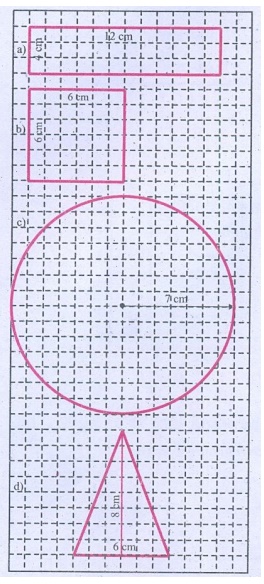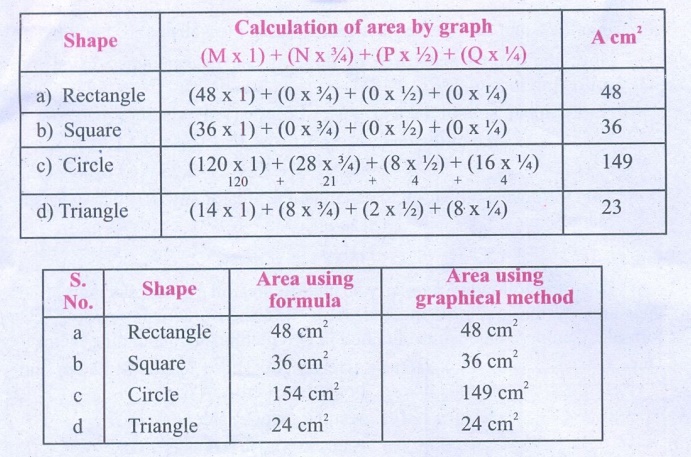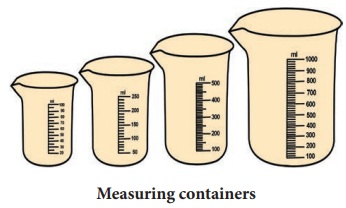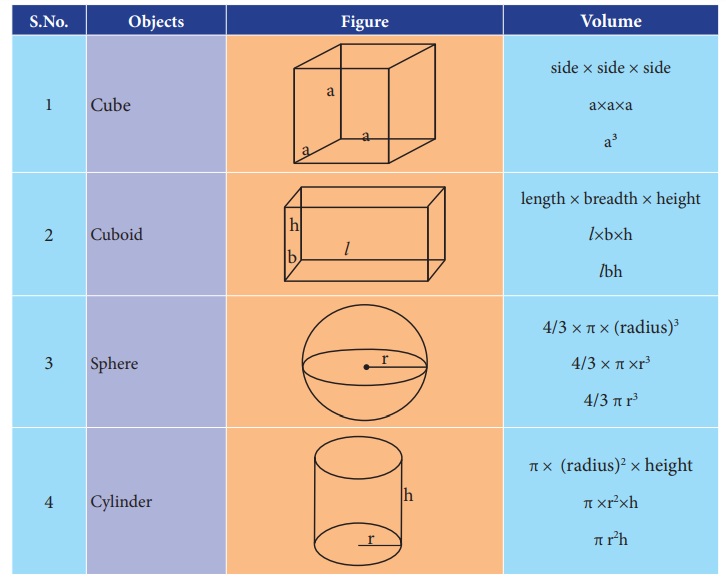Measurement | Term 1 Unit 1 | 7th Science - Volume | 7th Science : Term 1 Unit 1 : Measurement
Chapter: 7th Science : Term 1 Unit 1 : Measurement
Volume
Volume
The amount of space occupied by a three dimensional object is known as its volume.
volume = surface area × height
The SI unit of volume is cubic metre or m3
Volume of regularly shaped objects
As in the case of area, the volume of the regularly shaped objects can also be determined using an appropriate formula.
Table 1.3 gives the formulae used to calculate the volume of these regularly shaped objects.
Problem 1.3
Find the volume of (Take π = 22/7)
i. a cube whose side is 3 cm.
ii. a cylinder whose radius is 3 m and height is 7 m.
Solution:
a. Volume of a cube = side × side × side = 3 cm × 3 cm × 3 cm = 27 cubic cm or cm3.
b. Volume of a cylinder = π × r2 × height = (22/7) × 3 × 3 × 7 = 198 m3.
ACTIVITY 2
Draw the following regularly shaped figures on a graph sheet and find their area by the graphical method. Also, find their area using appropriate formula. Compare the results obtained in two methods by tabulating them.
a. A rectangle whose length is 12 cm and breadth is 4 cm.
b. A square whose side is 6 cm.
c. A circle whose radius is 7 cm.
d. A triangle whose base is 6 cm and height is 8 cm.


a) A = a × b
= 12 × 4 cm2
= 48 cm2
M × 1 = 48 × 1 = 48 cm2
b) A = a × a = 6 × 6 cm2
= 36 cm2
M × 1 = 36 × 1 = 36cm2
c) A = πr2
= 22/7 × 7 × 7
= 154 cm2
d) A = 1/2 ab = 1/2 × 6
× 8
= 24 cm2

Volume of liquids
Liquids also occupy some space and hencethey also have volume. But, liquids do not possess any definite shape. So, the volume of a liquid cannot be determined as in the case of solids. When a liquid is poured into a container, it takes the shape and volume of the container. The volume of any liquid is equal to the space that it fills and it can be measured using a measuring cylinder or measuring beaker. The maximum volume of liquid that a container can hold is known as the “capacity of the container”. A measuring container is graduated as shown in figure.

The volume of a liquid is equal to the volume of space it fills in the container. This can be directly observed from the readings marked in the measuring containers. If we notice the measuring cups given in figure carefully, we can observe that the readings are marked in the unit of “ml”. This actually represents millilitre. To understand this unit of volume, let us first understand how much a litre means. Litre is the commonly used unit to measure the volume of liquids. we can understand that the unit of volume is cubic cm if the dimensions of the object are given in cm. This cubic cm is commonly known as cc. A volume of 1000 cc is termed as one litre (l).
1 litre = 1000 cc or cm3
1000 ml = 1 litre
To measure the volume of liquids, some other units are also used. Some of them are gallon, ounce, and quart.
1 gallon = 3785 ml
1 ounce = 30 ml
1 quart = 1 litre
Table 1.3 Volume of regularly shaped objects

Volume of irregularly shaped objects
As we discussed earlier for the case of area, there are no formulae to determine the volume of irregularly shapedobjects. For such cases, their volume can be determined using a measuring cylinder and water.
Related Topics